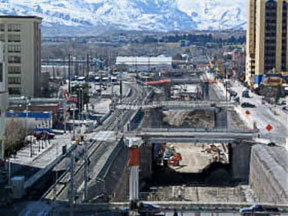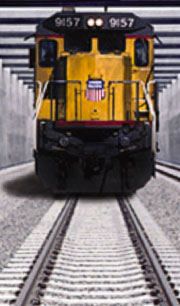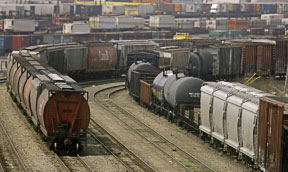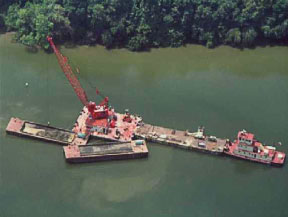Project: Reno RETRACK Rail – Near and Long Term Impacts of Rail System Improvements

Pika Environmental staff evaluated the air quality impacts of consolidating rail traffic into a proposed below-grade corridor through the City of Reno. Temporary traffic impacts during construction were severe, but traffic improvements at major intersections in future years due to elimination of train delays were determined to be substantial.
Pika Environmental documented these trends using techniques such as MOBILE5 and CALINE modeling. Since particulate matter is a major issue in Nevada, Pika Environmental staff also developed comprehensive construction dust management techniques to mitigate particulate emissions.
In addition to conducting a detailed evaluation of land uses to identify sensitive receptors (day care centers, schools, hospitals, and nursing homes), Pika Environmental staff also:
- Evaluated potential impacts from excavation of soils containing lead.
- Characterized construction emissions using construction sequencing estimates, equipment lists, and emission factors.
- Estimated locomotive emissions with Union Pacific input on load factors and fleet engine designs.
- Characterized vehicular traffic at intersections using local planning information, traffic counts, and assumptions regarding vehicle mix such as provided by EMFAC7 and other databases.
- Performed air dispersion modeling using ISC and CALINE4.
- Compared modeled ground level concentrations to ambient air quality standards (AAQS) and conducted exposure assessments.
- Quantified regional air quality benefits associated with improved traffic circulation for project alternatives.
- Where modeled impacts exceeded AAQS or other criteria, developed mitigation measures to reduce impacts below these levels.
- Conducted a Federal conformity analysis for the Truckee Meadows area for carbon monoxide, ozone, and particulate matter.
- Coordinated negotiations to obtain approvals from agencies, including the Federal Highway Administration.
- Demonstrated consistency of the project with the State Implementation Plan control measures.
Project: Air Quality Benefit Studies – Alameda Corridor Tariff and Pilot Shuttle Train Studies

Pika Environmental staff has conducted a variety of air emission studies to quantify benefits associated with rail infrastructure improvement projects in the Los Angeles basin.
As part of these studies, our staff has evaluated air quality benefits from consolidation of pre-existing rail lines with longer routes into a more direct route to downtown, allowing trains to operate at faster speeds; elimination of vehicular wait times and emission reductions at grade crossings; and increased rail capacity on a consolidated corridor which enables more cargo to be transported by rail rather than truck. The emission benefits study looked at emission benefits realized to date as well as projecting benefits for future years as strategies for NAAQS attainment.
Our staff utilized the Emission Factor (EMFAC) 2002 model to determine Heavy Duty Diesel Truck (HDDT) emission factors as well as U.S. Environmental Protection Agency (EPA) Tier I and II locomotive emission factors to develop emission scenarios for existing conditions as well as for the years 2005 and 2012.
Our technical arguments were subsequently able to demonstrate that imposing a tariff on rail would actually increase pollution in the South Coast Air Basin as truck transport would become economically favorable to importers. Our calculation methods were subsequently used by the Ports of Los Angeles and Long Beach in crafting the rail transportation portion of the San Pedro Ports Clean Air Action Plan.
Project: Inland Empire Main Line Study

For the Southern California Association of Governments, Pika Environmental staff conducted an emissions analysis for the Inland Empire Rail Road Main Line Study. Increased trade through the Ports of Los Angeles and Long Beach has caused an extraordinary growth in freight rail traffic over the last two decades, and rail commuter and regional passenger train services have experienced remarkable growth and rail traffic is expected to continue.
Our staff analyzed emissions impacts for criteria pollutants as part of an overall simulation of railroad infrastructure needs and operations in the greater Los Angeles Basin, extending from Los Angeles east to Barstow and Indio to enhance railroad throughput and productivity in the Inland Empire. Pika Environmental staff quantified rail efficiency and associated emissions benefits within the Main Line Rail Network for existing conditions and future years 2010 and 2025, and routing freight and passenger trains on three alternative routes. Weston researched railroad, California Air Resources Board (CARB) and EPA data and quantified emission reduction benefits, resulting from decreases in freight and passenger train total travel times, and concentration of heavy freight train operations on routes that are more grade-separated.
Our staff derived emission factors for vehicular delays at grade crossings along the study area main lines utilizing EMFAC 2002, and incorporated future SCAG-specific emission control measures including alternate diesel fuels and locomotive engine standards. In 2002 Weston participated in the Los Angeles-Inland Empire Railroad Main Line Advanced Planning Study. The analysis included growth projections, rail capacity improvements, and funding strategies to upgrade Southern California's rail infrastructure to accommodate for the rapid growth of container traffic. The emission benefits for both projects were included in the Transportation Implementation Plan as strategies for eventually attaining national ambient air quality standards in the Los Angeles area.
Project: Air Quality Implication Manuscript – San Francisco Bay Regional Dredged Material Management Plan (DMMP), US Army Corp of Engineers (US ACE)

Pika Environmental staff authored an air quality section of the DMMP regarding implications of the Disposal and Beneficial Use of Dredged Material from the San Francisco Bay. The manuscript/analysis supports the adoption of the USACE San Francisco District regional perspective for use of dredged material and builds upon previously developed Long-Term Management Strategy (LTMS) for San Francisco Bay Area. The Air Quality section addresses process, policy and control measures to reduce impacts for Suisun Bay, San Pablo Bay, Central and South San Francisco Bays.

